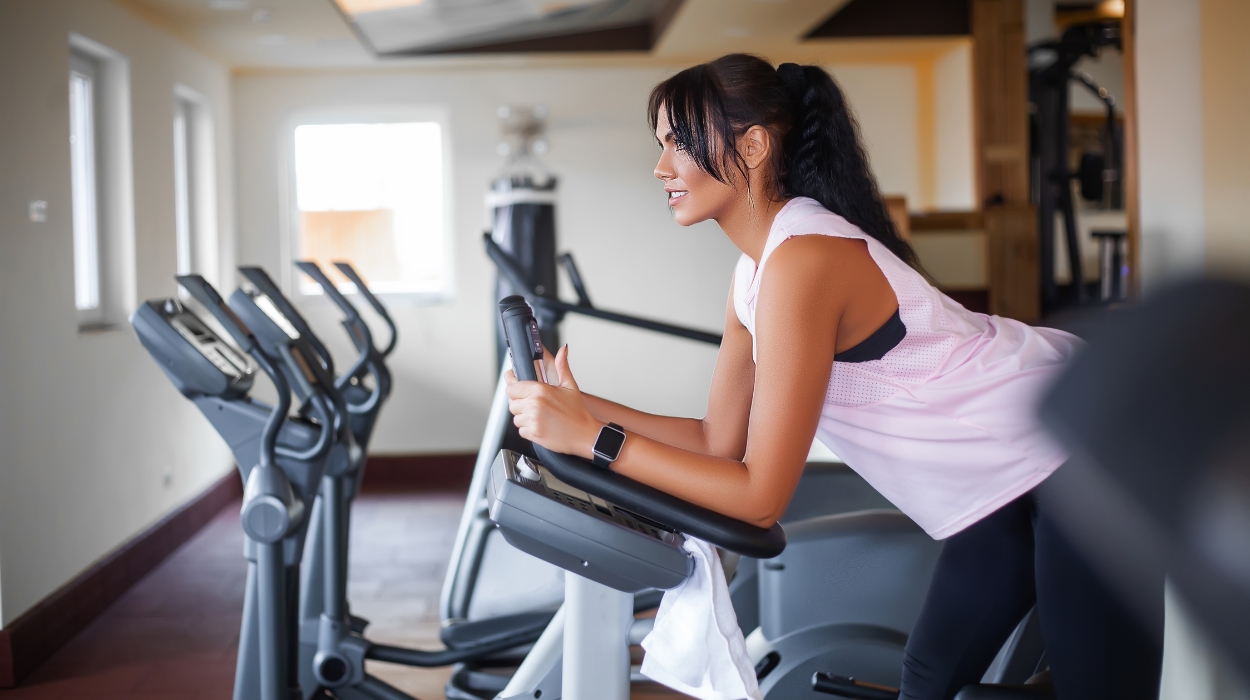 Expert's opinion
Expert's opinion
Expert's opinion
The article is a subjective view on this topic written by writers specializing in medical writing.
It may reflect on a personal journey surrounding struggles with an illness or medical condition, involve product comparisons, diet considerations, or other health-related opinions.
Although the view is entirely that of the writer, it is based on academic experiences and scientific research they have conducted; it is fact-checked by a team of degreed medical experts, and validated by sources attached to the article.
The numbers in parenthesis (1,2,3) will take you to clickable links to related scientific papers.
Stationary Bike For Weight Loss: Benefits & Effective Tips 2024

Riding a bicycle can strengthen your heart and lungs while also improving your body’s ability to utilize oxygen. It can even help you with your weight loss journey. Although outdoor cycling is a great low-impact exercise, not everyone is comfortable riding a bike, plus the weather doesn’t always cooperate.
Stationary bikes have become very popular over the years, both at gyms and in people’s homes who prefer not to go to a gym. When used properly, you can get a great cardio workout. For adults aged 18-64, the World Health Organization recommends[1] that you exercise five days a week for at least 30 minutes per day.
Stationary Bike For Weight Loss: How Much Weight To Lose With Exercise Bike?
To lose one pound of body weight, you need to burn 3,500 calories more than you consume. This means that a 125-pound person would need to cycle 5.5-8.5 hours per week to burn one pound of fat, and 3.5-5.5 hours for a 185-pound one.
Using a stationary exercise bike, you can burn anywhere between 40-80 calories in just 10 minutes, depending on your body weight, length of time exercising, heart rate, and exercise intensity. It is a great way to shed fat from your lower body as it activates the glutes, quads, hamstrings, and calves.
It is estimated that a 125-pound person who cycles for 30 minutes on a stationary bike can burn 211 calories. A 155-pound person can burn around 252 calories at a moderate pace for 30 minutes and 278 calories at a vigorous pace. A 185-pound person can burn 311 calories at the same time and intensity.
However, these numbers are just estimates, and your calorie burn depends on your biological sex, age, weight, body composition, and resting metabolic rate. The CDC states you can easily lose one to two pounds per week[2] for healthy and sustainable weight loss.
Stationary Exercise Bike Benefits
Boosts cardio fitness
Exercise bikes for cycling are excellent to get your heart pumping by increasing your heart rate and allowing your heart muscles to work harder to keep up with the oxygen demand.
A study[3] in the Journal of the American Heart Association found that bicycling to work, for example, helped prevent clinical cardiovascular risk factors among middle‐aged men and women.
Can help with weight loss

Using an exercise bike can help you lose weight by burning a lot of calories depending on the intensity of your workout. In other words, the longer you pedal while maintaining your heart rate in the fat-burning zone for your age, the more calories you will burn.
Lowers cholesterol
Exercise promotes good cholesterol and lowers bad cholesterol. These positive effects on cholesterol have been analyzed in many scientific studies. A minimum of 150 minutes of moderate-intensity exercise per week[4] is advisable for people aiming to lower bad low-density lipoprotein cholesterol levels.
Provides a low-impact workout
Stationary bike workout benefits the knees, ankles, and hip joints while improving the range of motion. Stationary cycling is also recommended for rehabilitation, especially after a knee or ankle sprain.
Cycling is easy on your body because it’s a closed chain exercise, which means it’s connected to a fixed object — in this case, the pedals — creating less stress on the body. This closed chain makes it a gentle option for people who want an intense workout without stressing their joints.
Dyan Tsiumis, CPT, a personal trainer with MYX Fitness
Strengthens legs and lower body muscles
By adding resistance and speed to your routine, your body must work harder. This added resistance builds strength in your legs, butt, and lower back.
Good for lungs and breathing capacity
When you exercise, your heart pumps faster to get more oxygen to your muscles. This in turn causes you to breathe faster to take in more oxygen, increasing your lung capacity. This increased breathing exercises your lungs.
Improves balance
Besides improving balance, the exercise bike helps improve coordination and gait. This can be especially useful for the elderly to prevent falls and fractures.
Safer than road cycling
Unless you are on a designated bike path, riding along highways, roads, and city streets can offer obstacles and rough riding that can prove unsafe. Riding a stationary bike eliminates these dangers. National Highway Traffic Safety Administration statistics[5] show that in most years since 2000, between 700 and 800 Americans have been killed in bike crashes while thousands more have been injured, mostly from automobiles.
How Long Does It Take To Lose Weight?

Studies have shown you will not see results overnight. For most people, it takes a couple of months to notice changes. As a general rule, if you are consistent with your workouts and eating well, it takes about a month for you to notice your body is changing.
Indoor cycling really can help lose weight:
Be consistent with your biking workouts. Try to ride every day for at least 30 minutes each day.
Todd Buckingham, Ph.D.
Weight Loss Facts
Everyone has a certain number of calories they use and burn each day just to function normally depending on factors like your gender and age. The number of calories burned depends on your body weight, how long you cycle, and the intensity of your cycling. You will find different answers as to how much weight you can lose riding a stationary bike. Basically, how much you lose is dependent on how many calories you burn.
To maintain your specific weight, you need to eat food that will supply the number of calories you need. Everything that your body does is fueled by calories, from running and jumping to smiling and even just breathing. When it comes to weight loss, you need a deficit in calories. In other words, you need to eat fewer calories than your body needs to maintain its current weight. Exercising burns calories, thus contributing to the deficit that you need to lose weight.
To lose weight, you need to make sure your heart rate (HR) is in the fat-burning zone for a minimum of 30 minutes. The fat-burning zone refers to how fast your heart rate should be when you are exercising. You will need an HR monitor on your exercise bike or an HR monitor bracelet or watch. You can also calculate your HR by using the simple calculation of 220 minus your age. For losing weight, your HR should be between 65%-70% of your maximum heart rate for your age. Getting up to this fat-burning zone and maintaining it for at least 30 minutes will help you to reach your goal.
Tips For Weight Loss Success
- Be consistent. Maintain a regular routine. This will give you the best results and get you to your goal faster.
- Start off pedaling at a low intensity for 5-10 minutes. Switch to medium intensity for 3-5 minutes. Alternate between high intensity (1-3 minutes) and medium intensity (3-5 minutes) for the next 20 to 30 minutes.
- Use resistance. If you are just starting, don’t use resistance. As you get more in shape, start your resistance at one and work up slowly to the maximum for your exercise bike. It is important not to rush as this may cause muscle fatigue and injury.
- Try LISS which means Low-Intensity Steady-State cardio. For lower intensity, keep your HR between 50-65% of your maximum HR. This approach also invites audio or video entertainment for more pleasure while you exercise.
- Try HIIT for more intense exercise. HIIT means high-intensity interval training where you can alternate speed and intensity for more calories burned.
- Proper form is also important when using an exercise bike. Pay attention to seat height, seat position, pedal, and handlebar positions. You want to be in a comfortable position without causing injury.
Conclusion
Working out is important, but your results will take longer if you don’t eat a calorie-controlled and healthy diet. The right healthy diet will help you to achieve your weight loss and muscle tone goals by giving your body the fuel it needs. By drinking plenty of water throughout the day you can also boost your metabolism and curb hunger.
Regular stationary bike workouts have great benefits for your body, health, and mood. Exercise helps us feel good and this positive effect is not only psychological but beneficial for your body.
Exercise bikes are great for weight loss because they get you moving and burning calories, which in turn assists in creating or maintaining a calorie deficit. Stationary bikes are also convenient machines that take up minimal space and offer results without taking up too much of your time.
+ 5 sources
Health Canal avoids using tertiary references. We have strict sourcing guidelines and rely on peer-reviewed studies, academic researches from medical associations and institutions. To ensure the accuracy of articles in Health Canal, you can read more about the editorial process here
- World Health Organization (2022). Physical activity. [online] Available at: https://www.who.int/news-room/fact-sheets/detail/physical-activity.
- CDC (2023). Losing Weight. [online] Centers for Disease Control and Prevention. Available at: https://www.cdc.gov/healthyweight/losing_weight/index.html.
- Anders Grøntved, Koivula, R.W., Johansson, I., Wennberg, P., Lars Østergaard, Göran Hallmans, Renström, F. and Franks, P.W. (2016). Bicycling to Work and Primordial Prevention of Cardiovascular Risk: A Cohort Study Among Swedish Men and Women. [online] 5(11). doi:https://doi.org/10.1161/jaha.116.004413.
- Mann, S.V., Beedie, C. and Jimenez, A. (2013). Differential Effects of Aerobic Exercise, Resistance Training and Combined Exercise Modalities on Cholesterol and the Lipid Profile: Review, Synthesis and Recommendations. [online] 44(2), pp.211–221. doi:https://doi.org/10.1007/s40279-013-0110-5.
- NHTSA. (2021). Bicycle Safety. [online] Available at: https://www.nhtsa.gov/road-safety/bicycle-safety.



